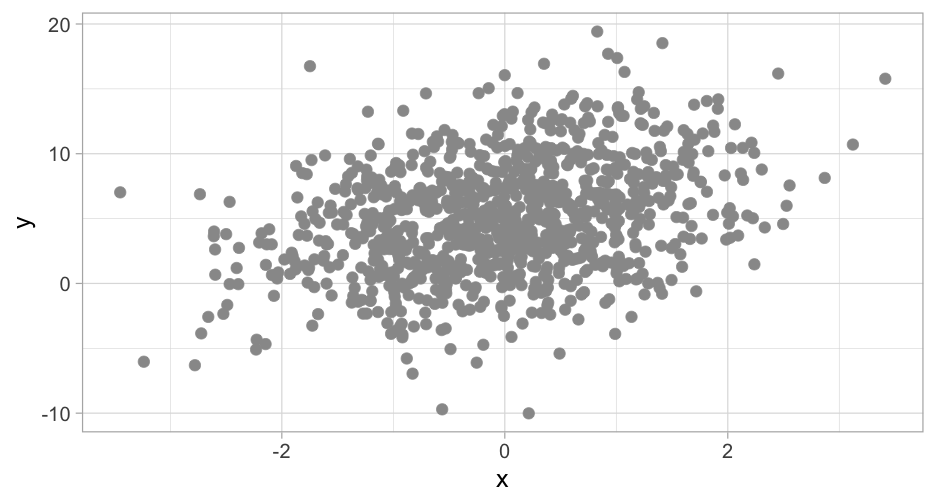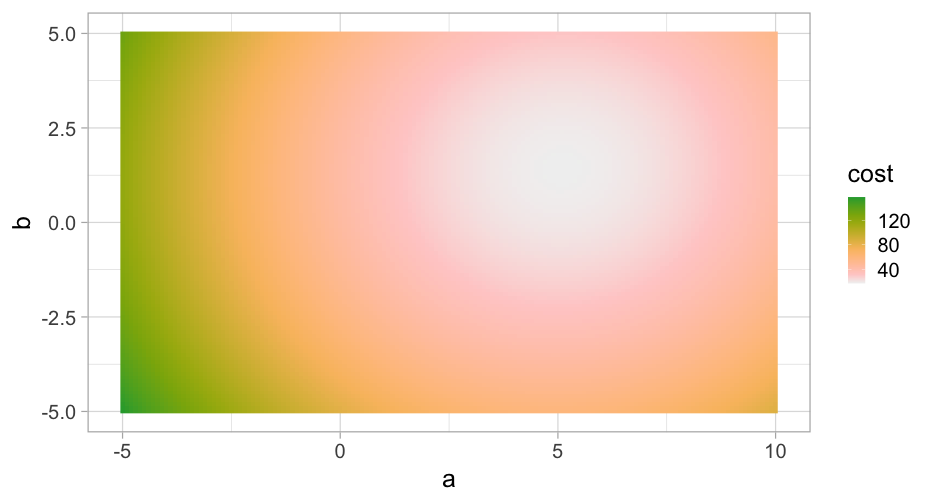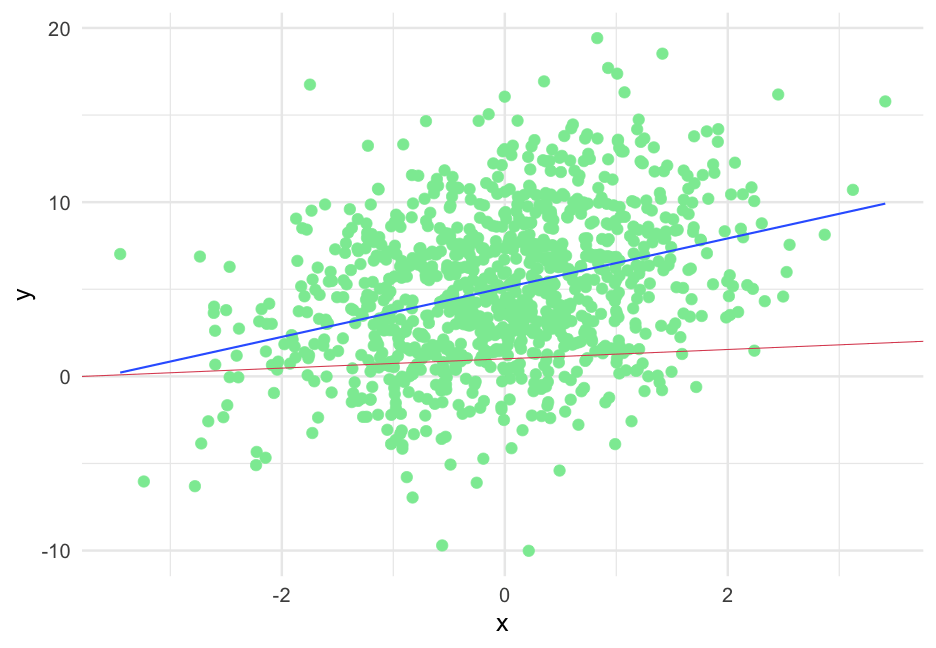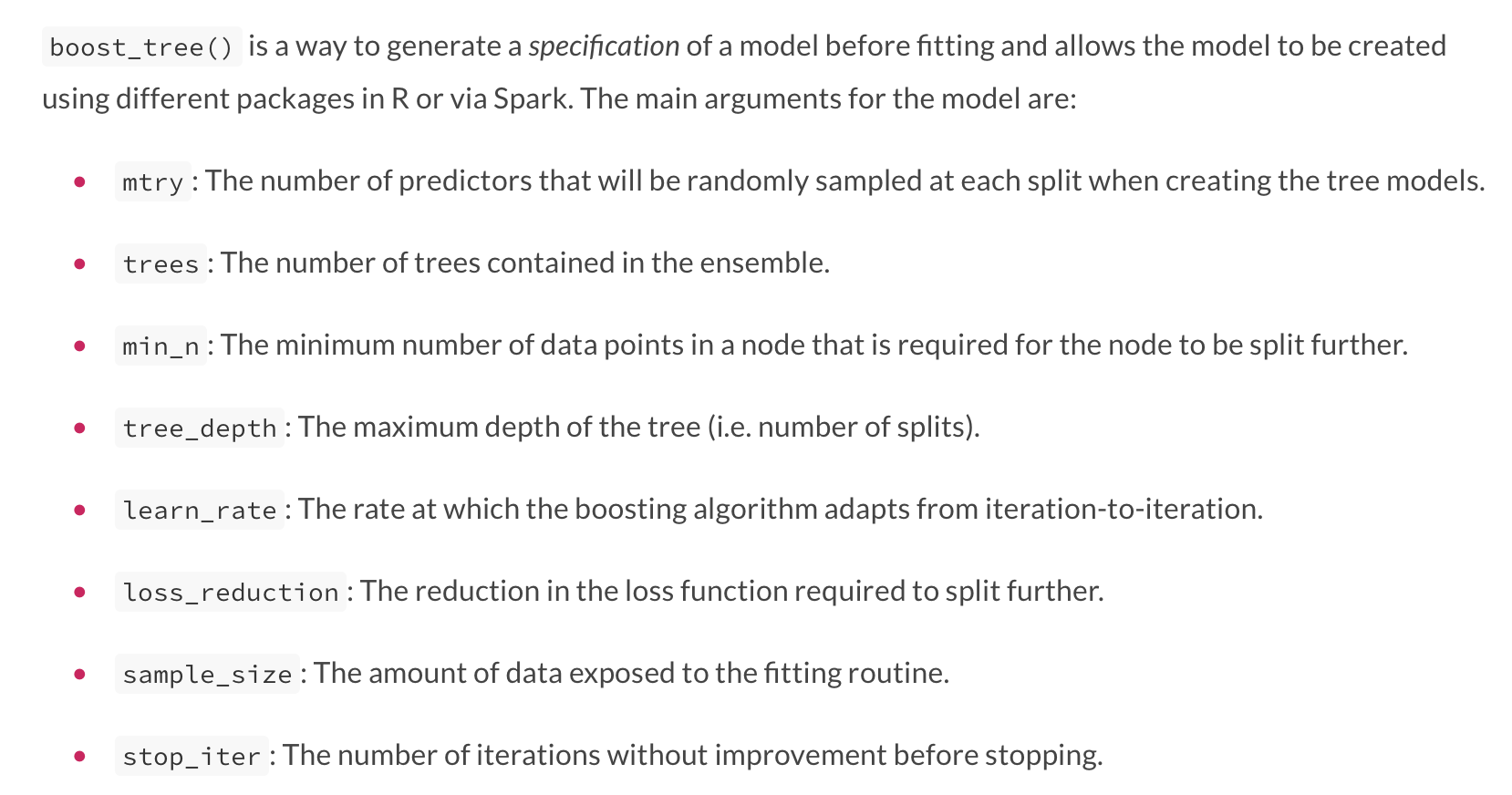class: center, middle, inverse, title-slide # Gradient Boosting (with trees) ### Daniel Anderson ### Week 9, Class 1 --- # Agenda * Boosting * Gradient descent * Standard boosted tree hyperparameters * Additional hyperparameters with **{xgboost}** * Initial implementation with {tidymodels} + This will mostly be for Wednesday --- # Quick scheduling note * Next Monday, we have a scheduled work day. This is intended for you to work with your group on your final project, while having Joe and I present to help you work though any problems + If you are having specific issues, that would be a great time for us to help you solve them + Otherwise, it's a designated time for you all to work together -- * Next Wednesday, we will cover [Keras](https://keras.rstudio.com/index.html) in [#rstats](https://twitter.com/hashtag/rstats) * Keras is a high-level API for neural nets - can use numerous back-ends for estimation, including [TensorFlow](https://www.tensorflow.org) --- # Before Wednesday! Please run the following: ```r install.packages("keras") keras::install_keras() ``` We'll run through some basic models and hopefully have you fitting some basic neural nets by the end Please do this ASAP, and if you run into issues, please contact me --- # Quick review * For bagged trees and random forests, we create `\(b\)` bootstrap resamples of the training data. We then fit a model to each resample and aggregate the results for a single prediction -- * Random forests include an additional stochastic component, sampling `\(m\)` features for each split in each tree for every resample, which can help decorrelate the trees and lead to better predictions -- * For each of these models, you need a *sufficient* number of resamples to obtain a stable estimate, but additional resamples will only "cost" in terms of computational efficiency --- # Boosting * Like bagging, boosting is a general algorithm that can be applied to any model, but it's very common with trees -- * Like bagging, boosting is an ensemble approach, where many models are fit to the data -- ### Key difference from bagging * Rather than using boostrapping, boosted models are built .b[.ital[sequentially]], with each model fit to the residuals from the previous -- * information from tree 1 .b[feeds into] tree 2, which .b[feeds into] tree 3... etc. --- background-image: url(https://bradleyboehmke.github.io/HOML/images/boosted-trees-process.png) background-size: contain # Boosting illustrated .footnote[https://bradleyboehmke.github.io/HOML/gbm.html] --- # Components of boosting * .bolder[.b[Base learner]]: The model that is iteratively fit. Can be any model but is regularly a .ital[shallow] decision tree -- * .bolder[.b[Weak models]]: Improves error rate only slightly more than chance. The weak learning is boosted by the iterative fit, and the model learns slow + Trees with 1-6 splits are common -- * .bolder[.b[Sequential fit]]: See algorithm on next slide --- # Sequential fitting algorithm 1. Fit a decision tree to the data: `\(f_1\left(x\right) = y\)` -- 2. Fit a second decision tree to the residuals of the first: `\(h_1\left(x\right) = y - f_1\left(x\right)\)` -- 3. Add the trees together to obtain an ensemble algorithm: `\(f_2\left(x\right) = f_1\left(x\right) + h_1\left(x\right)\)` -- 4. Fit a new decision tree to the residuals of this model: `\(h_2\left(x\right) = y - f_2\left(x\right)\)` -- 5. Add this tree to our ensemble: `\(f_3\left(x\right) = f_2\left(x\right) + h_2\left(x\right)\)` -- 6. Continue onward until some criterion (stopping rule) is met --- # Final Model $$ f\left(x\right) = \sum^B_{b=1}f^b\left(x\right) $$ --- # Slow learning * Boosted models typically .ital[learn slow], which may sound bad, but is actually helpful in finding an optimal solution -- * Each tree is very shallow, and learns little about the data on its own -- * By contrast, random forests include aggregation across many deep, independent trees (i.e., each tree learns a lot, but variance is reduced through averaging) --- background-image: url(https://bradleyboehmke.github.io/HOML/10-gradient-boosting_files/figure-html/boosting-in-action-1.png) background-size: contain class: inverse ### Slow Learning Illustrated .footnote[https://bradleyboehmke.github.io/HOML/gbm.html] --- # Note, this doesn't mean it's always optimal * In a simple linear regression case, where we *know* how the data were generated, linear regression still wins! * This can be the case even if we *don't know* how the underlying data were generated, but the problem is relatively simple. --- # Quick example ```r set.seed(3) # parameters alpha <- 10 b1 <- 5 x <- 1:100 log_x <- log(x) e <- rnorm(length(x), sd = 0.8) #outcome y <- alpha + b1*log_x + e sim <- data.frame(x, y) ``` --- # Plot ```r library(tidyverse) ggplot(sim, aes(x, y)) + geom_point() ``` <!-- --> --- # Modeling * In this case, the "best" model is one that models exactly the function that created the data - log transforming `x` * We can get *close* to this with a spline * Although a boosted tree model is often among the best "out of the box" models, it will not do as well as either of the previous models, in this (very simple case) --- # Illustration ### Create recipes for log transformation and a B-spline Quick side-note: Any idea why I'm using a B-spline instead of a natural spline? ```r library(tidymodels) rec_log <- recipe(y ~ x, sim) %>% step_log(x) rec_spline <- recipe(y ~ x, sim) %>% step_bs(x, deg_free = tune()) ``` --- # Candidate models * I'm omitting the code for for boosted trees because I'll be fitting it outside of the **{tidymodels}** framework, but we'll get there soon (wiht **{tidymodels}**). ```r # linear regression lin_mod <- linear_reg() %>% set_mode("regression") %>% set_engine("lm") ``` --- # Create CV object, estimate ```r cv_lin <- vfold_cv(sim) # fit log transform log_fit <- fit_resamples(lin_mod, rec_log, cv_lin) collect_metrics(log_fit) ``` ``` ## # A tibble: 2 x 5 ## .metric .estimator mean n std_err ## <chr> <chr> <dbl> <int> <dbl> ## 1 rmse standard 0.6776624 10 0.03110880 ## 2 rsq standard 0.9701750 10 0.008851531 ``` --- # Tune spline ```r grid_spline <- grid_regular(deg_free(c(3, 25)), levels = 15) tuned_spline <- tune_grid(lin_mod, rec_spline, cv_lin, grid = grid_spline) rec_spline_f <- finalize_recipe(rec_spline, select_best(tuned_spline, metric = "rmse")) fit_spline <- fit_resamples(lin_mod, rec_spline_f, cv_lin) collect_metrics(fit_spline) ``` ``` ## # A tibble: 2 x 5 ## .metric .estimator mean n std_err ## <chr> <chr> <dbl> <int> <dbl> ## 1 rmse standard 0.7103735 10 0.04391925 ## 2 rsq standard 0.9702860 10 0.007592861 ``` --- # Standard boosted tree ``` ## # A tibble: 2 x 5 ## # Groups: .metric [2] ## .metric .estimator mean n std_err ## <chr> <chr> <dbl> <dbl> <dbl> ## 1 rmse standard 1.554065 10 0.9951414 ## 2 rsq standard 0.9155545 10 0.08098759 ``` Note that the boosted tree model has both lower average performance *and* higher variance. -- Does that mean it's a crappy model and we shouldn't be learning it? **No!** It just means that in this one, very simple case, it doesn't perform as well as simpler models --- # Visualizing these fits <!-- --> --- # Out of the box performance * Despite what we just saw, boosted tree models are typically one of the "best" out-of-the-box model for performance on tabular data * One of the most frequent algorithms used across Kaggle winners (although there's a few new variants that have been gaining popularity) * A boosted model "when appropriately tuned, is often hard to beat with other algorithms" ([Bohemke & Greenwell](https://bradleyboehmke.github.io/HOML/gbm.html)) * Doesn't mean it's **always** better than simpler models, but if you have complex data, it's likely to perform well. --- class: inverse center middle # Gradient Descent --- # Gradient Descent * General purpose optimization algorithm -- * Gradient descent and its variants (e.g., stochastic gradient descent) are used throughout many advanced ML applications (e.g., deep learning) -- * Evaluate prediction against a cost function (objective function to minimize) and move in direction of steepest descent until you reach a minimum -- * Gradient descent is used with boosted trees to inform how each subsequent tree should be built --- background-image:url(https://ml-cheatsheet.readthedocs.io/en/latest/_images/gradient_descent.png) background-size: cover .footnote[https://ml-cheatsheet.readthedocs.io/en/latest/gradient_descent.html] --- class: inverse center middle # Learning rate --- # Illustration with linear regression ### Feel free to follow along! * First, simulate some data ```r set.seed(8675309) n <- 1000 x <- rnorm(n) a <- 5 b <- 1.3 e <- 4 y <- a + b*x + rnorm(n, sd = e) ``` --- # Plot ```r sim_d <- tibble(x = x, y = y) ggplot(sim_d, aes(x, y)) + geom_point() ``` <!-- --> --- # Estimate w/OLS Note that this is both *really fast* (about a tenth of a second) and is the best, linear, unbiased estimate (BLUE) ```r sim_ols <- lm(y ~ x) summary(sim_ols) ``` ``` ## ## Call: ## lm(formula = y ~ x) ## ## Residuals: ## Min 1Q Median 3Q Max ## -15.4097 -2.8122 -0.1298 2.7710 14.1251 ## ## Coefficients: ## Estimate Std. Error t value Pr(>|t|) ## (Intercept) 5.0924 0.1298 39.22 <2e-16 *** ## x 1.4135 0.1270 11.13 <2e-16 *** ## --- ## Signif. codes: 0 '***' 0.001 '**' 0.01 '*' 0.05 '.' 0.1 ' ' 1 ## ## Residual standard error: 4.104 on 998 degrees of freedom ## Multiple R-squared: 0.1104, Adjusted R-squared: 0.1095 ## F-statistic: 123.8 on 1 and 998 DF, p-value: < 2.2e-16 ``` --- # Estimate with gradient descent * First, define the cost function (mean square error) $$ \frac{1}{N} \sum_{i=1}^{n} (y_i - (a + bx_i ))^2 $$ -- * Next, calculate the partial derivative of each parameter .g[this is not my strong suit] -- $$ \begin{bmatrix} \frac{d}{da}\\\\ \frac{d}{db}\\\\ \end{bmatrix} = \begin{bmatrix} \frac{1}{N} \sum -2(y_i - (a + bx_i)) \\\\ \frac{1}{N} \sum -2x_i(y_i - (a + bx_i)) \\\\ \end{bmatrix} $$ --- # Gradient descent * The partial derivatives of the cost function define gradient -- * We move in the steepest direction -- * The amount we move is defined by our learning rate, which is multiplied by the partial derivative values -- * The resulting value is then subtracted (because we're minimizing) from our *current* parameter estimate -- * Iterate until no improvements are made --- # Gradient descent "by hand" Let's start by writing a function to calculate the mean squared error (our cost function) ```r mse <- function(a, b, x = sim_d$x, y = sim_d$y) { prediction <- a + b*x # model prediction, given intercept/slope residuals <- y - prediction # distance between prediction & observed squared_residuals <- residuals^2 # squared to avoid summation to zero ssr <- sum(squared_residuals) # sum of squared distances mean(ssr) # average of squared distances } ``` --- # Double check Does our function work? Let's use the OLS coefficients to compute the MSE, then compare this to what we get from the actual model residuals. ```r mse(a = coef(sim_ols)[1], b = coef(sim_ols)[2]) ``` ``` ## [1] 16809.93 ``` ```r sum(resid(sim_ols)^2) ``` ``` ## [1] 16809.93 ``` ### Hooray! --- # Explore other candidate lines We're trying to minimize the MSE. Let's just try a few other lines ```r mse(0.5, 3) ``` ``` ## [1] 40915.99 ``` ```r mse(1, 2) ``` ``` ## [1] 34044.36 ``` ```r mse(1, 3) ``` ``` ## [1] 36531.42 ``` ```r mse(1, 1.5) ``` ``` ## [1] 33584.1 ``` --- # Plot these lines ```r ggplot(sim_d, aes(x, y)) + geom_point() + geom_abline(intercept = 0.5, slope = 3) + geom_abline(intercept = 1, slope = 2) + geom_abline(intercept = 1, slope = 3) + geom_abline(intercept = 0.5, slope = 1.5) ``` <!-- --> --- # View Cost Surface ```r library(colorspace) grid <- expand.grid(a = seq(-5, 10, 0.1), b = seq(-5, 5, 0.1)) grid <- grid %>% mutate(cost = map2_dbl(a, b, mse)) surface <- ggplot(grid, aes(a, b)) + geom_raster(aes(fill = cost)) + scale_fill_continuous_sequential(palette = "Terrain") ``` --- <!-- --> --- # 3D version ```r library(rayshader) plot_gg(surface, multicore = TRUE) render_movie(filename = here::here("slides", "img", "cost-surface.mp4"), title_text = 'Cost surface', phi = 30 , theta = -45) ``` --- background-image:url("img/cost-surface.mp4") backgroun-size:contain --- # Find the minimum value In this case, we've just calculated the cost function for a big range of values. Pretty easy to find the minimum. ```r grid %>% arrange(cost) %>% slice(1) ``` ``` ## a b cost ## 1 5.1 1.4 16810.19 ``` But this is only possible because the problem is so simple. It's not an *efficient* approach, and would quickly become infeasible. --- # Gradient descent * Start at a random location, go downhill until you can't anymore * The gradient is determined by the partial derivative of the model parameters -- Reminder: these are the partial derivatives for the MSE with an intercept and one slope $$ \begin{bmatrix} \frac{d}{da}\\\\ \frac{d}{db}\\\\ \end{bmatrix} = \begin{bmatrix} \frac{1}{N} \sum -2(y_i - (a + bx_i)) \\\\ \frac{1}{N} \sum -2x_i(y_i - (a + bx_i)) \\\\ \end{bmatrix} $$ --- # Compute the gradient Let's write a function that computes the gradient for any point on the cost surface ```r compute_gradient <- function(a, b, x = sim_d$x, y = sim_d$y) { n <- length(y) predictions <- a + (b * x) residuals <- y - predictions da <- (1/n) * sum(-2*residuals) db <- (1/n) * sum(-2*x*residuals) c(da, db) } ``` --- # Take a step downhill We'll use the gradient to take a step in the steepest direction. The size of the step is determined by the learning rate. ```r gd_step <- function(a, b, learning_rate = 0.1, x = sim_d$x, y = sim_d$y) { grad <- compute_gradient(a, b, x, y) step_a <- grad[1] * learning_rate step_b <- grad[2] * learning_rate c(a - step_a, b - step_b) } ``` --- # Start "walking" ```r walk_downhill <- gd_step(0, 0) # random start location walk_downhill ``` ``` ## [1] 1.0109553 0.2681521 ``` -- Take another step *from* the new location - recalculating the gradient and stepping in the steepest direction -- ```r walk_downhill <- gd_step(walk_downhill[1], walk_downhill[2]) walk_downhill ``` ``` ## [1] 1.8211460 0.4856731 ``` --- # Keep walking ```r walk_downhill <- gd_step(walk_downhill[1], walk_downhill[2]) walk_downhill ``` ``` ## [1] 2.4704558 0.6620702 ``` ```r walk_downhill <- gd_step(walk_downhill[1], walk_downhill[2]) walk_downhill ``` ``` ## [1] 2.9908419 0.8050772 ``` ```r walk_downhill <- gd_step(walk_downhill[1], walk_downhill[2]) walk_downhill ``` ``` ## [1] 3.4079116 0.9209825 ``` --- # Watch it go! * Keep running the previous line to watch the parameter values update. * After a while, compare the result to the OLS solution, see if you need to keep going. --- # Do it in a loop ```r run <- gd_step(0, 0) for(i in seq_len(500)) { run <- gd_step(run[1], run[2]) } run ``` ``` ## [1] 5.092374 1.413514 ``` ```r coef(lm(y ~ x)) ``` ``` ## (Intercept) x ## 5.092374 1.413514 ``` --- # Try again, but save everything ```r estimate_gradient <- function(pars_tbl, learning_rate = 0.1, x = sim_d$x, y = sim_d$y) { pars <- gd_step(pars_tbl[["a"]], pars_tbl[["b"]], learning_rate) tibble(a = pars[1], b = pars[2], mse = mse(a, b, x, y)) } ``` --- ```r # initialize grad <- estimate_gradient(tibble(a = 0, b = 0)) # loop through for(i in 2:50) { grad[i, ] <- estimate_gradient(grad[i - 1, ]) } grad ``` ``` ## # A tibble: 50 x 3 ## a b mse ## <dbl> <dbl> <dbl> ## 1 1.010955 0.2681521 34589.27 ## 2 1.821146 0.4856731 28248.48 ## 3 2.470456 0.6620702 24169.29 ## 4 2.990842 0.8050772 21544.96 ## 5 3.407912 0.9209825 19856.56 ## 6 3.742184 1.014897 18770.26 ## 7 4.010101 1.090974 18071.32 ## 8 4.224840 1.152586 17621.61 ## 9 4.396959 1.202471 17332.24 ## 10 4.534919 1.242853 17146.04 ## # … with 40 more rows ``` --- # Plot learning curve ```r grad <- grad %>% rowid_to_column("iteration") ggplot(grad, aes(iteration, mse)) + geom_line() ``` <!-- --> --- # Walk downhill ```r ggplot(grid, aes(a, b)) + geom_raster(aes(fill = cost)) + colorspace::scale_fill_continuous_sequential(palette = "Terrain") + guides(fill = "none") + geom_point(data = grad, color = "gray40", alpha = 0.5, stroke = 0) ``` <!-- --> --- # Visualize change in slope ```r ggplot(sim_d, aes(x, y)) + geom_point(color = "#8beaa2") + geom_abline(aes(intercept = a, slope = b), data = grad, color = "gray60", size = 0.3) + geom_abline(aes(intercept = a, slope = b), data = grad[nrow(grad), ], color = "magenta") ``` <!-- --> --- # Animate it! ```r library(gganimate) ggplot(grad) + geom_point(aes(x, y), sim_d, color = "#8beaa2") + geom_smooth(aes(x, y), sim_d, method = "lm", se = FALSE) + geom_abline(aes(intercept = a, slope = b), color = "#de4f60") + transition_manual(frames = iteration) ``` --- <!-- --> --- background-image:url(img/poly-gd.gif) background-size: contain # Quick look at polynomial regression --- # Why do this? * For algorithms like linear regression, we wouldn't. We have a closed-form solution to minimize the sum of the squared errors. -- * For many algorithms, there is no closed-form solution. So - define a cost function, and go "downhill" until you reach a minimum -- * Downside? Slower than a closed-form solution (have to estimate iteratively) -- * Upside? We can minimize a cost function in a much more general way. --- # Why spend so much time on this? This is how boosted trees work * Start by fitting a shallow tree * Subsequent tree splits are determined by the values are steepest in the gradient of the cost function * "Step" that direction by multiplying by the learning rate The learning rate is also called *shrinkage*, because it is reducing (shrinking) the speed at which the algorithm moves downhill (a value of 1.0 would be no shrinkage, but values greater that 0.3 are rare) --- class: inverse center middle # Back to Boosted Trees --- # Hyperparameters Standard boosted trees include the following four hyperparameters * Tree depth * Minimum `\(n\)` for a terminal node * `\(n\)` trees * Learning rate --- # Tree depth * Just like standard decision trees, the tree depth is an important hyperparameter -- * However, with boosted trees we typically grow very shallow trees - an ensemble of "stumps" is common, and typical trees range from 3-6 splits -- * Stumps are computationally efficient (but require more trees) * Deeper trees (more splits) may capture important interactions, but have a higher risk of overfitting -- .b[Tree depth (number of splits) is a highly important hyperparameter] --- # `\(n\)` trees * Unlike boosted trees and random forests, the number of trees .b[is] a hyperparameter -- * The number of trees fit to the data will determine how much is learned -- ### Probably obvious but... * Too few trees, and the model will underfit * Too many trees, and the model will overfit -- This is a really important hyperparameter for standard decision trees Its optimization will depend on the tree depth .g[Shallower trees will learn less, and will be optimized at a higher number of total trees] --- background-image:url(https://bradleyboehmke.github.io/HOML/10-gradient-boosting_files/figure-html/learning-rate-fig-1.png) background-size:contain # Learning rate * The size of the step taken at each iteration during gradient descent optimization .footnote[[Figure from HML](https://bradleyboehmke.github.io/HOML/gbm.html)] --- # Another way to think of it .pull-left[  ] -- .pull-right[  ] --- # Learning rate Also called .ital[shrinkage] * Values range from 0-1, but typically range from 0.001 to 0.3 -- ### Smaller values: * Mean less is learned from each tree, making it more robust to specific characteristics of any individual tree, and good generalizations * Make it easier to stop early & avoid overfitting * Greater potential for "optimal" accuracy -- ### .b[But] * Also prone to local minima * Lead to a more computationally intensive model & will require more trees --- # Minimum `\(n\)` per terminal node * Technically a hyperparameter, but rarely comes into play * Trees are not grown sufficiently deep for it to matter (usually) --- # Standard boosted tree tuning strategy 1. Start out with a relatively high learning rate (I generally start at `\(0.1\)`) 2. Determine optimal `\(n\)` trees (for this learning rate) 3. Fix tree `\(n\)` and tune learning rate 4. Tune tree-specific parameters for chosen learning rate 5. Fix tree-specific parameters, lower learning rate to see if you can make any further gains --- class: inverse center middle # Extensions -- Everything we've discussed so far would be considered a .b[standard] gradient boosted tree -- The most common package for .b[standard] gradient boosted trees is [{gbm}](https://github.com/gbm-developers/gbm), which is not implemented in {tidymodels}. -- So... let's proceed with further complications! --- # Stochastic GBM * Similar to bagged trees and random forests, introducing randomness to the sample and/or the features can sometimes help predictive accuracy -- * Sampling of cases is conducted for each tree + Subsample between 50%-80% of the training data for each tree .footnote[Note - other subsample values will regularly work better, but somewhere in this range should be your starting point] -- * Sampling of features can be conducted by tree .b[or] by split (or actually by depth level) --- # Model tuning Bokhmke & Greenwell note: > we have not seen strong interactions between the stochastic hyperparameters and the other boosting and tree-specific hyperparameters -- Recommend evaluating random sampling proportions either with tree-specific hyperparameters, or after finalizing all the previous steps --- # Hyperparameters We are now at .b[7] hyperparameters (and we're not done yet): * Tree depth * `\(n\)` trees * Learning rate * Minimum `\(n\)` for a terminal node * Subsample of rows * Subsample of columns for each .ital[tree] * Subsample of columns for each .ital[split] .g[Not implemented in tidymodels but easy to add] --- # XGBoost e.b[X]treme .b[G]radient .b[Boost]ing -- * Primary algorithm implemented in .ital[tidymodels] (that we're concerned with) -- * Optimized distributed boosting (i.e., fast) -- * Includes .b[even more] hyperparameter options, but we'll only mention a few of these --- # Gamma (aka `loss_reduction`) * Controls tree depth * Specifies a minimum loss required for further splits * Scale dependent, and ranges from `\(0 - \infty\)` -- * Boehmke & Greenwell note that values between 1-20 are common -- * L1 and L2 penalties are also available in {xgboost}, but have to be passed directly to the model function. The arguments are `alpha` and `gamma`, respectively. --- # Early stopping * New/different way of controlling both the speed of your alogorithm .ital[and] the complexity of your model -- * Because the number of trees is a hyperparamter, it helps guard against overfiting -- ### How? * Specify a number, `\(n\)`, to tell the algorithm to stop after the algorithm is not improving --- # Tuning an XGBoost model * These additional regularizers change the way we approach tuning our model -- * Instead of first assessing how many trees are needed, we'll specify a large number of treees to be built, but specify an early stopping rule -- * Tune the learning rate, then tree-specific parameters, then stochastic components -- * Retune learning rate if your find values that are really different than defaults -- * If CV error suggests substantial overfitting, crank up regluarization --- class: inverse center normal # Implementation with **{tidymodels}** I'm assuming we're mostly out of time --- # {parsnip} * When we set a model, we just use `boost_tree()` for our model, and `set_engine("xgboost")` * Essentially everything else is the same -- ```r boosted_tree_spec <- boost_tree() %>% set_engine("xgboost") %>% set_mode("regression") %>% # or classification, of course set_args(...) ``` --- # Quick note on performance By default, **{xgboost}** will use all the processors on your computer You can override this with the `nthread` argument when you `set_engine()`, e.g., `set_engine("xgboost", nthread = 2)` The `xgboost` package is *highly* performant compared to other similar algorithms, and it works great on the cluster --- # Hyperparameters See the full documentation [here](https://parsnip.tidymodels.org/reference/boost_tree.html) We'll actually start fitting models on Wednesday 